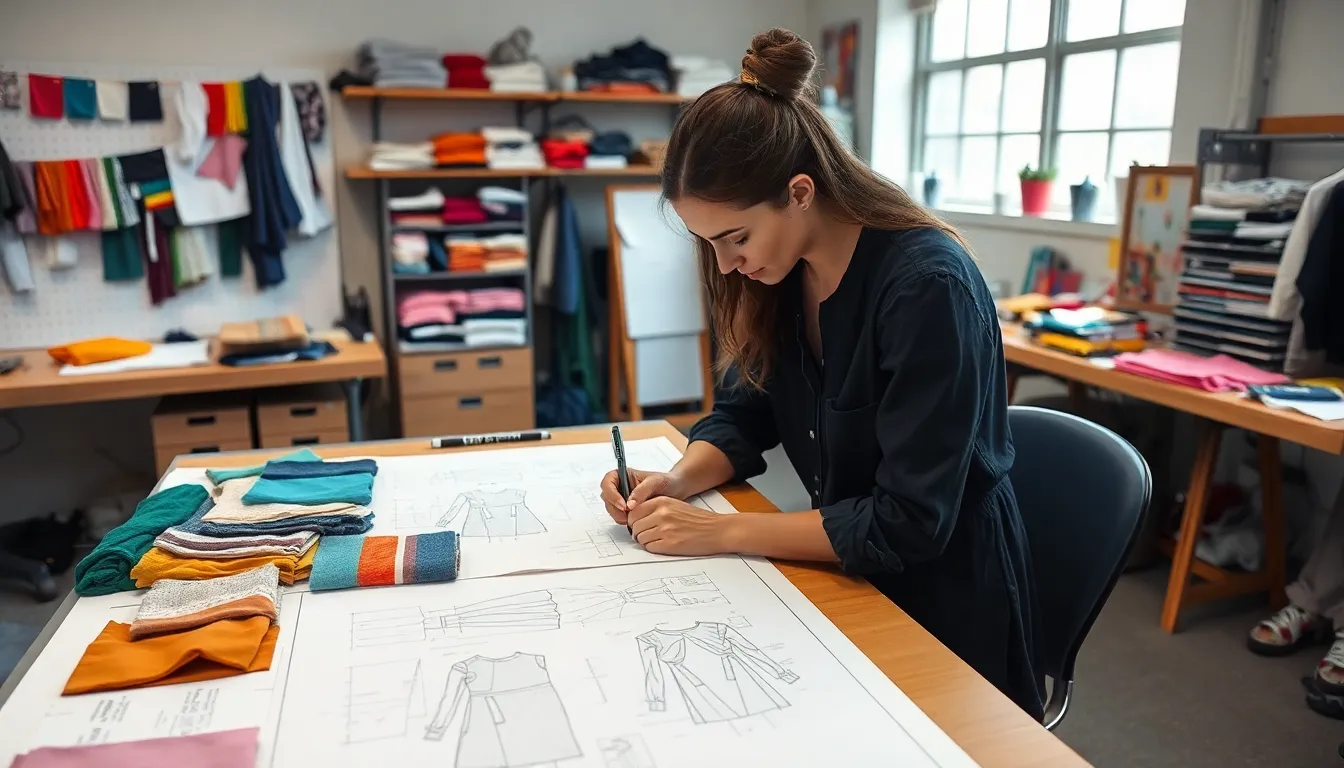Creating a tech pack might sound like a task reserved for the fashion elite, but it’s actually a game-changer for anyone looking to turn their creative ideas into reality. Think of it as the blueprint for your design dreams—without it, you might as well be building a house without a plan. Who wants a wardrobe malfunction waiting to happen?
Table of Contents
ToggleUnderstanding Tech Packs
A tech pack is an essential document in the fashion industry, detailing all elements required to produce a garment. This comprehensive outline includes specifications for materials, measurements, colors, and construction techniques. Designers rely on tech packs to communicate their vision clearly to manufacturers.
Key components of a tech pack typically encompass technical drawings, known as flat sketches. Flat sketches provide a visual representation of the design, highlighting dimensions and any unique features. Each drawing should be accompanied by annotations, detailing every component and its specifications.
Material swatches play a significant role in tech packs. These samples of fabrics, trims, and other materials bring the designer’s vision to life, allowing manufacturers to understand the texture and quality desired. Including accurate swatch references is vital.
Incorporating a bill of materials, or BOM, outlines every item needed for production. This list ensures the correct quantities of each material are ordered, reducing the likelihood of delays or errors during manufacturing. Each garment’s BOM should be precise.
Measurement charts are integral to a tech pack as well. These charts provide size specifications for each size offered, ensuring consistency during production. Clear measurement guidelines help manufacturers deliver products that meet design requirements.
Lastly, adding care instructions in the tech pack informs consumers on proper garment maintenance. This information enhances the product’s value and assists manufacturers in producing labels correctly. Including these details safeguards the integrity of the final product.
A well-prepared tech pack mitigates design errors, strengthens communication, and facilitates a smoother production process. Embracing these elements will significantly benefit anyone aiming to turn fashion concepts into reality.
Essential Components of a Tech Pack

A tech pack consists of various key elements that ensure effective communication between designers and manufacturers. These components form the foundation for successful garment production.
Specifications
Specifications define the details necessary for creating a garment. Dimensions, sizes, and tolerances outline the precise measurements required. Including details like stitch types influences construction quality. Manufacturers rely on clear specifications to minimize errors. Accuracy in this section significantly impacts the final product’s fit and overall appearance.
Design Elements
Design elements bring the visual aspect of the garment to life. Technical drawings depict the style from multiple angles, demonstrating features and construction details. Flat sketches highlight the unique aspects of the design, while color palettes establish the visual identity. An effective design section communicates the designer’s vision accurately and ensures alignment between creative intent and manufacturing capabilities.
Materials and Fabrics
Materials and fabrics sections outline the components that make up the garment. Including swatches helps convey texture and quality, allowing manufacturers to visualize the final product accurately. Selecting materials impacts not only aesthetics but also functionality and durability. Providing comprehensive details about each fabric type ensures consistency throughout production, ultimately enhancing the garment’s performance and appeal.
Steps to Create a Tech Pack
Creating a tech pack involves several important steps that transform ideas into actionable plans.
Research and Inspiration
Gathering research on current fashion trends is essential. Designers often explore various sources like magazines, websites, and social media for inspiration. Identifying styles, colors, and materials that resonate with the target audience helps define the collection. Collecting visual references ensures alignment with market expectations. Taking notes during this phase aids in clarifying design concepts, making the next steps smoother.
Drafting the Technical Specifications
Writing detailed technical specifications is crucial for clarity. Start with measurements that specify garment sizes, ensuring uniformity in production. Include material descriptions that highlight composition and texture, crucial for manufacturers. Creating a bill of materials outlines every component needed and prevents ordering errors. Providing accurate stitching types further communicates quality expectations. Incorporating care instructions enhances product longevity and value.
Finalizing the Design
Finalizing the design solidifies the vision into tangible format. Reviewing technical drawings ensures that all details are represented accurately. Collaborating with team members during this phase enhances creativity and opportunity for refinement. Making necessary adjustments based on feedback can lead to improved functionality. Completing this step involves ensuring all components from specifications to visuals are cohesive, guaranteeing a comprehensive tech pack for production.
Tips for an Effective Tech Pack
Creating an effective tech pack involves attention to detail and clear communication. Start with comprehensive technical drawings, as these visual aids outline design features and dimensions. Accurate measurements ensure consistency across productions, reducing chances of errors.
Incorporate material swatches to showcase the desired texture and quality. Including a bill of materials (BOM) simplifies ordering by listing every item required for production. These elements minimize delays and errors in the manufacturing process.
Ensure specifications are precise. Details like dimensions and stitch types influence construction quality that directly impacts the final product. Adopt a structured format for the tech pack to enhance clarity and facilitate understanding for manufacturers.
Multiple revisions improve the tech pack’s effectiveness. Sharing drafts with team members promotes collaboration and identifies potential adjustments early in the process. Consistent feedback loops lead to a more cohesive document.
Prioritize care instructions, as they add value to the product. Clear instructions help consumers maintain the garment’s appearance and longevity. Visual elements such as color palettes enhance the aesthetic appeal, aligning closely with the design intent.
Finally, finalizing the tech pack requires thorough review. Cross-check all components for accuracy, ensuring alignment between creative vision and practical execution. Done correctly, an effective tech pack becomes an invaluable resource in translating fashion ideas into reality.
Common Mistakes to Avoid
Designers often overlook the importance of including detailed measurements in their tech pack. Inaccuracy can lead to significant production issues, resulting in misfit garments. Not specifying fabric choices adequately creates complications during manufacturing, as manufacturers rely on exact materials to meet design expectations.
Rushing through the technical drawings frequently leads to confusion. Clear and precise drawings are critical for effective communication between designers and manufacturers. Skipping the inclusion of a bill of materials (BOM) can delay the production process, as it identifies all necessary items and their quantities.
Failing to communicate care instructions also impacts the end product’s quality. Detailed care guidelines help manufacturers understand how to treat fabrics correctly, avoiding damage during production. Neglecting to collaborate with team members can diminish the tech pack’s effectiveness, as different perspectives often enhance the final design.
Inconsistency in color palettes creates confusion and misalignment with the original vision. Color standards should always be specific to ensure manufacturers achieve the desired results. Designers might forget to add revision notes, which help track changes and ensure that everyone is on the same page throughout the process.
Underestimating the importance of thorough reviews at each stage can lead to overlooked errors. Each section of the tech pack deserves careful evaluation to verify clarity and completeness. Addressing these common mistakes strengthens the tech pack and facilitates a smoother production journey.
Creating a tech pack is an essential step for anyone in the fashion industry. It serves as the foundation for successful garment production and ensures that every detail aligns with the designer’s vision. By incorporating precise specifications technical drawings and material swatches designers can minimize errors and streamline communication with manufacturers.
Attention to detail is crucial throughout the process. By avoiding common pitfalls and thoroughly reviewing each component designers can create a tech pack that not only reflects their creative intent but also enhances the overall quality of the final product. With a well-prepared tech pack in hand bringing fashion ideas to life becomes a more manageable and efficient endeavor.








